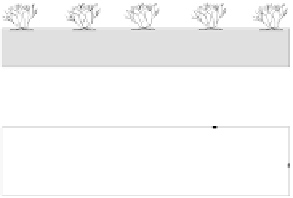Environmental Engineering Reference
In-Depth Information
and, say, 30 years after closure). The disadvantages of this approach are two-fold.
First, larger volumes of leachate must be treated; this has economic consequences
for the proponent. Second, if the leachate collection system fails, a high infiltration
will result in significant leachate mounding.
Drainage layer
Vegetated surface layer
Geomembrane
Clayey soil or GCL
Soil base layer
Waste
Gas Drainage layer
Figure 16.1.
Passive cover
Vegetated surface
Soil cover
Waste
Figure 16.2.
Active cover
On the basis of the previous considerations, it is apparent that the performance of
a confinement system is influenced not only by the deposit geometry, type of waste,
climatic conditions and lining materials, but also by land-filling history and
management activity.
The introduction of performance design and its increasing acceptance by the
geoenvironmental community has led to a rethink on how landfill containment
system design should be tackled. It is obvious that with this new trend the design
engineer must take into account numerous parameters such as contaminant transport
parameters and service life of the mineral barriers, drainage layers, geosynthetics,
and the main features of the waste, in order to be able to estimate the leachate
quality and production during landfill activity and after closure. A list of the main
parameters that should be defined for reliably evaluating the pollutant migration
scenario from a landfill is presented in Table 16.1. Today, most of these parameters
are easily assessable, whereas some are presently being investigated through
research programs and therefore their estimation is not currently completely reliable.

















































































































































































































































































